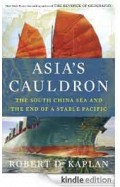Asias Cauldron The South China Sea and the End of a Stable Pacific
By: Robert D. Kaplan
-
Rs 997.50
- Rs 1,995.00
- 50%
-

You save Rs 997.50.
Due to constant currency fluctuation, prices are subject to change with or without notice.
| Book | |
| What's in the Box? | 1 x Asias Cauldron The South China Sea and the End of a Stable Pacific |
Monsoon The Indian Ocean And The Future Of American Power
By: Robert D. Kaplan
Rs 3,325.50 Rs 3,695.00 Ex Tax :Rs 3,325.50
The Revenge of Geography What the Map Tells Us about Coming Conflicts and the Battle Against Fate
By: Robert D. Kaplan
Rs 3,865.50 Rs 4,295.00 Ex Tax :Rs 3,865.50
Asias Cauldron The South China Sea and the End of a Stable Pacific
By: Robert D. Kaplan
Rs 997.50 Rs 1,995.00 Ex Tax :Rs 997.50
In Europes Shadow Two Cold Wars and a ThirtyYear Journey Through Romania and Beyond
By: Robert D. Kaplan
Rs 746.25 Rs 995.00 Ex Tax :Rs 746.25
Earning the Rockies How Geography Shapes Americas Role in the World
By: Robert D. Kaplan
Rs 1,837.50 Rs 2,450.00 Ex Tax :Rs 1,837.50
The Return of Marco Polo's World: War, Strategy, and American Interests in the Twenty-first Century - (PB)
By: Robert D. Kaplan
Rs 2,847.50 Rs 5,695.00 Ex Tax :Rs 2,847.50
Imperial Grunts - The American Military on the Ground
By: Robert D. Kaplan
Rs 1,100.75 Rs 1,295.00 Ex Tax :Rs 1,100.75
The Tragic Mind - Fear, Fate, and the Burden of Power
By: Robert D. Kaplan
Rs 8,545.50 Rs 9,495.00 Ex Tax :Rs 8,545.50
The Tragic Mind - Fear, Fate, and the Burden of Power
By: Robert D. Kaplan
Rs 5,485.50 Rs 6,095.00 Ex Tax :Rs 5,485.50
Zubin Mehta: A Musical Journey (An Authorized Biography)
By: VOID - Bakhtiar K. Dadabhoy
Rs 892.50 Rs 1,050.00 Ex Tax :Rs 892.50
The Secret War in Afghanistan: The Soviet Union China and AngloAmerican Intelligence in the Afghan War Library of Middle East History
By: Panagiotis Dimitrakis
Rs 3,395.75 Rs 3,995.00 Ex Tax :Rs 3,395.75
Sideways on a Scooter: Life and Love in India
By: Miranda Kennedy
Rs 1,615.00 Rs 1,900.00 Ex Tax :Rs 1,615.00
The Mughal Throne The Saga Of Indias Great Emperors
By: Abraham Eraly
Rs 3,595.50 Rs 3,995.00 Ex Tax :Rs 3,595.50
The Great Game On Secret Service In High Asia
By: Peter Hopkirk
Rs 1,597.50 Rs 3,195.00 Ex Tax :Rs 1,597.50
From Third World to First Intl Singapore And The Asian Economic Boom - (PB)
By: Lee Kuan Yew
Rs 2,695.50 Rs 2,995.00 Ex Tax :Rs 2,695.50
The Faithful Scribe: A Story of Islam Pakistan Family and War
By: Shahan Mufti
Rs 2,290.75 Rs 2,695.00 Ex Tax :Rs 2,290.75
Josiah the Great: The True Story of The Man Who Would Be King
By: Ben Macintyre
Rs 845.75 Rs 995.00 Ex Tax :Rs 845.75
The Secret War in Afghanistan: The Soviet Union China and AngloAmerican Intelligence in the Afghan War Library of Middle East History
By: Panagiotis Dimitrakis
Rs 3,395.75 Rs 3,995.00 Ex Tax :Rs 3,395.75
Mycroft Holmes and The Apocalypse Handbook
By: Kareem Abdul-Jabbar
Rs 1,270.75 Rs 1,495.00 Ex Tax :Rs 1,270.75
Hunderd Stories Of Hadhrat Ayesha
By: Mufti Afzal Hossen Elias
Rs 522.00 Rs 580.00 Ex Tax :Rs 522.00
Zubin Mehta: A Musical Journey (An Authorized Biography)
By: VOID - Bakhtiar K. Dadabhoy
Rs 892.50 Rs 1,050.00 Ex Tax :Rs 892.50
Monsoon The Indian Ocean And The Future Of American Power
By: Robert D. Kaplan
Rs 3,325.50 Rs 3,695.00 Ex Tax :Rs 3,325.50
The Revenge of Geography What the Map Tells Us about Coming Conflicts and the Battle Against Fate
By: Robert D. Kaplan
Rs 3,865.50 Rs 4,295.00 Ex Tax :Rs 3,865.50
Asias Cauldron The South China Sea and the End of a Stable Pacific
By: Robert D. Kaplan
Rs 997.50 Rs 1,995.00 Ex Tax :Rs 997.50
In Europes Shadow Two Cold Wars and a ThirtyYear Journey Through Romania and Beyond
By: Robert D. Kaplan
Rs 746.25 Rs 995.00 Ex Tax :Rs 746.25
Earning the Rockies How Geography Shapes Americas Role in the World
By: Robert D. Kaplan
Rs 1,837.50 Rs 2,450.00 Ex Tax :Rs 1,837.50
The Return of Marco Polo's World: War, Strategy, and American Interests in the Twenty-first Century - (PB)
By: Robert D. Kaplan
Rs 2,847.50 Rs 5,695.00 Ex Tax :Rs 2,847.50
Imperial Grunts - The American Military on the Ground
By: Robert D. Kaplan
Rs 1,100.75 Rs 1,295.00 Ex Tax :Rs 1,100.75
The Tragic Mind - Fear, Fate, and the Burden of Power
By: Robert D. Kaplan
Rs 8,545.50 Rs 9,495.00 Ex Tax :Rs 8,545.50
The Tragic Mind - Fear, Fate, and the Burden of Power
By: Robert D. Kaplan
Rs 5,485.50 Rs 6,095.00 Ex Tax :Rs 5,485.50
The Secret War in Afghanistan: The Soviet Union China and AngloAmerican Intelligence in the Afghan War Library of Middle East History
By: Panagiotis Dimitrakis
Rs 3,395.75 Rs 3,995.00 Ex Tax :Rs 3,395.75


















-120x187.jpg?q6)



-120x187.jpg?q6)












-120x187.jpg?q6)






